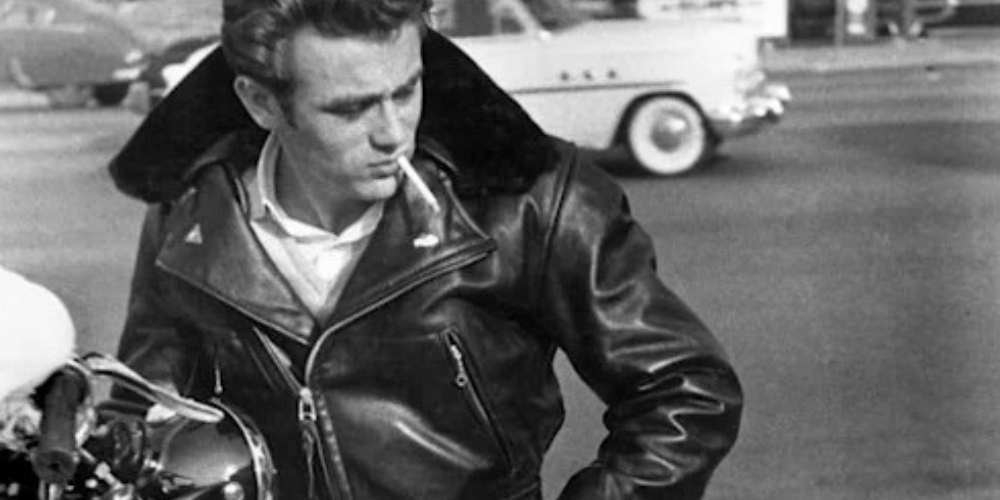Leather has an undeniable attraction, captivating us with its texture, scent, and timelessness. From the rebellious nature of the iconic leather jacket sported by James Dean in Rebel Without a Cause or Brando in ‘The Wild One’ to the rich patina of a 18th century Chesterfield or a mid-century Wassily Chair, this material holds a unique place in our collective consciousness. But what is it about leather that evokes such strong emotions and desires?
In this article, we explore the psychology behind our fascination with leather and why it holds such a special place in our hearts.
MATERIAL SYMBOLISM:
We associate leather with strength, durability, and status. Historically, leather was used for armour and protection, making it a symbol of resilience and power. In today’s modern world, leather continues to be evocative but in a more sophisticated, sometimes elitist way, with high-end fashion brands using it to create premium products that exude sophistication and a suggestion of class.
The evolution of leather and the journey it has taken, reflects our fascination for this material and the craftsmanship, sense of quality and the goal for beauty that often accompanies it.
SENSORY APPEAL:
The psychology behind leather is fascinating, just touching leather can evoke a range of emotions and sensations. The smoothness of fine leather can feel cool and comforting. Whereas the grainy texture of natural leather can feel rugged and adventurous. A leather’s ‘hand-feel’ is a term often used when discussing its quality.
Leather can be tanned in a number of different ways from the most ‘basic’ to purposefully retain original characteristics such as scars and brand marks to more processed articles which have a more uni-tone, consistent feel and appearance. Each style of leather can serve a particular purpose and help deliver a particular experience.
For example, our Shelly Anemone leather specified at Muswell Hill’s Everyman Cinema provides a luxurious but consistent and high-end aesthetic. This demonstrates a nostalgic nod back to the plush fixed seating of 20th Century movie theatres. This is in contrast with the Old English characterful articles used by BrewDog to purposely fit in-line with their brand aesthetic of bold punk attitude.
The psychology smell of leather can also be distinct and unmistakable, evoking a Proustian response such as nostalgia and familiarity transporting us to different times and places. This triggers memories and emotions associated with leather products. The combination of touch, smell, and visual appeal makes leather a multi-sensory experience that is deeply satisfying and rewarding.
If looked after, good quality leather can age well, building a unique patina over time reflecting the ‘journey’ the product has been on with each scratch, crease, and change in coloration representing a moment in time. This visual narrative adds character and authenticity to the leather, making it more than just a material possession. Pure aniline products such as Newcastle, Legacy and Old English patina particularly well. They’re also commonly used in environments requiring depth and character. (add relevant case studies here)
Natural Fit Spa is a perfect example of how leather can age well. The location in Brighton and Hove proudly features Crest’s Old English Tan for their second, members-only Spa and Gym. The spa features a combination of bold fabrics and tan leather sofas. This adds a touch of timeless elegance to the space, showcasing a thoughtful design aesthetic.
CULTURAL INFLUENCE:
Leather has a rich cultural history that has shaped our perceptions and attitudes towards this material. In many cultures, leather is associated with rituals and traditions, such as the use of leather in traditional clothing. For example, garments and accessories are often worn during ceremonial occasions to signify status, identity, or cultural heritage. For example, in some Indigenous cultures, traditional leather clothing is worn during rituals and ceremonies. This is done to honour ancestors and connect with spiritual beliefs.
One example of leather garments and accessories worn during ceremonial occasions to signify status, identity, or cultural heritage is the traditional Native American regalia. Among Indigenous peoples in North America, regalia plays a significant role in ceremonial and cultural events, including powwows, dances, and spiritual ceremonies. These regalia are often intricately crafted and adorned with leather, beads, feathers, and other symbolic elements.
For instance, in Plains Indian tribes like the Lakota, Dakota, and Cheyenne, traditional regalia for men might include a leather war shirt adorned with intricate beadwork and fringe, leather leggings, moccasins, and a feathered headdress. Each element of the regalia carries deep cultural significance, reflecting the wearer’s tribal identity, achievements, and spiritual beliefs.
Whether we’re drawn to leather for its appeal, symbolic significance, or cultural heritage. One thing is clear: leather holds a special place in our hearts and minds. This makes it a material that will continue to captivate and inspire.
 Our use of cookies
Our use of cookies 